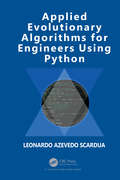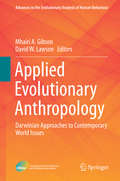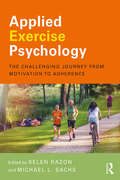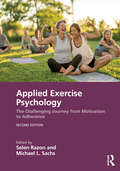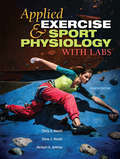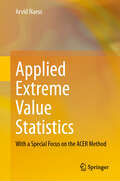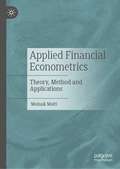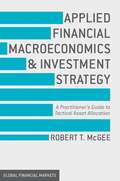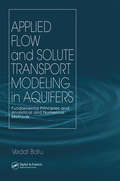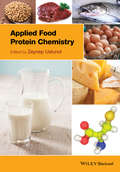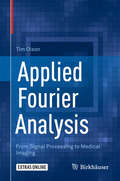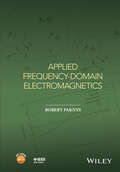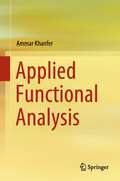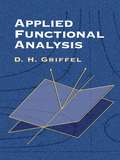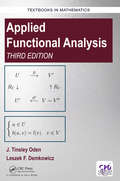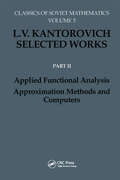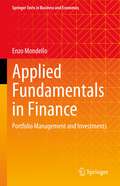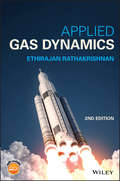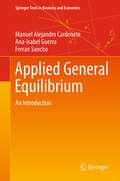- Table View
- List View
Applied Evolutionary Algorithms for Engineers using Python
by Leonardo Azevedo ScarduaApplied Evolutionary Algorithms for Engineers with Python is written for students, scientists and engineers who need to apply evolutionary algorithms to practical optimization problems. The presentation of the theoretical background is complemented with didactical Python implementations of evolutionary algorithms that researchers have recently applied to complex optimization problems. Cases of successful application of evolutionary algorithms to real-world like optimization problems are presented, together with source code that allows the reader to gain insight into the idiosyncrasies of the practical application of evolutionary algorithms. Key Features Includes detailed descriptions of evolutionary algorithm paradigms Provides didactic implementations of the algorithms in Python, a programming language that has been widely adopted by the AI community Discusses the application of evolutionary algorithms to real-world optimization problems Presents successful cases of the application of evolutionary algorithms to complex optimization problems, with auxiliary source code.
Applied Evolutionary Anthropology: Darwinian Approaches to Contemporary World Issues (Advances in the Evolutionary Analysis of Human Behaviour #1)
by Mhairi A. Gibson David W. LawsonAs a species, we are currently experiencing dramatic shifts in our lifestyle, family structure, health, and global contact. Evolutionary Anthropology provides a powerful theoretical framework to study such changes, revealing how current environments and legacies of past selection shape human diversity. This book is the first major review of the emerging field of Applied Evolutionary Anthropology bringing together the work of an international group of evolutionary scientists, addressing many of the major public health and social issues of this century. Through a series of case studies that span both rural and urban situations in Africa, Asia, Europe and South America, each chapter addresses topics such as natural resource management, health service delivery, population growth and the emergence of new family structures, dietary, and co-operative behaviours. The research presented identifies the great, largely untapped, potential that Applied Evolutionary Anthropology holds to guide the design, implementation and evaluation of effective social and public health policy. This book will be of interest to policy-makers and applied researchers, along with academics and students across the biological and social sciences.
Applied Exercise Psychology: The Challenging Journey from Motivation to Adherence
by Selen Razon Michael L. SachsApplied Exercise Psychology emphasizes the application of evidence-based knowledge drawn from the fields of exercise psychology, health psychology, clinical and counseling psychology, and exercise physiology for physical activity behavior change. The book provides readers with: theoretical bases for understanding and promoting physical activity behavior; interventions to use for facilitating physical activity behavior change and the tools for measuring the effectiveness of these interventions; cross-cultural considerations for practitioners to ensure multicultural competency; considerations to guide best practices with special populations (e.g., persons with medical conditions and persons with mental health conditions); overall applied implications and future directions. The collection builds a bridge between up-to-date research findings, relevant field experiences, and applied implications. This is the first book to cover such breadth of topics in applied exercise psychology, with chapters bringing often overlooked issues to the attention of practitioners to promote not only evidence-based practice but also responsible ethics and referral.
Applied Exercise Psychology: The Challenging Journey from Motivation to Adherence
by Selen Razon Michael L. SachsNow in its second edition, Applied Exercise Psychology emphasizes the application of evidence-based knowledge drawn from the fields of exercise psychology, health psychology, clinical and counseling psychology, and exercise physiology for physical activity behavior change. Thoroughly revised, the new edition offers readers: two new chapters covering Excusercise and Mood Alteration’s link to exercise; fully updated sections on current research and theoretical bases for understanding and promoting physical activity behavior; interventions for facilitating physical activity behavior change and the tools for measuring the effectiveness of these interventions; cross-cultural considerations for practitioners to ensure multicultural competency; considerations to guide best practices with special populations (e.g., persons with medical conditions and persons with mental health conditions); overall applied implications and future directions. An essential read that covers a variety of critical topics in applied exercise psychology, it brings often overlooked issues to the attention of practitioners to promote not only evidence-based practice but also responsible ethics and referral. The collection is a key reference for up-to-date research findings, relevant field experiences, and applied implications.
Applied Exercise and Sport Physiology, With Labs: With Labs
by Dona J. Housh Terry J. Housh Herbert A. DevriesApplied Exercise & Sport Physiology, Fourth Edition, presents theory and application in an appealing, balanced, and manageable format. By providing an essential introduction to the systems of the human body and covering important aspects of exercise and sport physiology, it will be a useful resource for students as they learn to become exercise science professionals, physician's assistants, physical therapists, physical educators, or coaches. It provides the right amount of practical information they will need to apply in hospitals, clinics, schools, and settings such as health clubs, youth sport leagues, and similar environments. The authors have carefully designed the material to be covered easily in one semester, in an introductory course, but the book can also serve as a foundation for advanced courses. Its 18 lab experiences are matched to relevant chapters and complement the topics covered; they allow readers to apply physiological principles to exercise and sport, provide opportunities for hands-on learning and application of the scientific principles, and often don't require complex equipment.
Applied Extreme Value Statistics: With a Special Focus on the ACER Method
by Arvid NaessThis book does not focus solely on asymptotic extreme value distributions. In addition to the traditional asymptotic methods, it introduces a data-driven, computer-based method, which provides insights into the exact extreme value distribution inherent in the data, and which avoids asymptotics. It therefore differs from currently available texts on extreme value statistics in one very important aspect. The method described provides a unique tool for diagnostics, and for efficient and accurate extreme value prediction based on measured or simulated data. It also has straightforward extensions to multivariate extreme value distributions. The first half provides an introduction to extreme value statistics with an emphasis on applications. It includes chapters on classical asymptotic theories and threshold exceedance models, with many illustrative examples. The mathematical level is elementary and, to increase readability, detailed mathematical proofs have been avoided in favour of heuristic arguments. The second half presents in some detail specialized topics that illustrate the power and the limitations of the concepts discussed. With diverse applications to science, engineering and finance, the techniques described in this book will be useful to readers from many different backgrounds.
Applied Family Law in Islamic Courts: Shari’a Courts in Gaza (Islamic Law in Context)
by Nahda ShehadaWritten from an ethnographic perspective, this book investigates the socio-legal aspects of Islamic jurisprudence in Gaza-Palestine. It examines the way judges, lawyers and litigants operate with respect to the law and with each other, particularly given their different positions in the power structure within the court and within society at large. The book aims at elucidating ambivalences in the codified statutes that allow the actors to find practical solutions to their (often) legally unresolved problems and to manipulate the law. The book demonstrates that present-day judges are not only confronted with novel questions they have to find an answer to, but, perhaps more importantly, they are confronted with contradictions between the letter of codified law and their own notions of justice. The author reminds us that these notions of justice should not be set a priori; they are socially constructed in particular time and space. Making a substantial contribution to a number of theoretical debates on family law and gender, the book will appeal to both academic and non-academic readers alike.
Applied Financial Econometrics: Theory, Method and Applications
by Moinak MaitiThis textbook gives students an approachable, down to earth resource for the study of financial econometrics. While the subject can be intimidating, primarily due to the mathematics and modelling involved, it is rewarding for students of finance and can be taught and learned in a straightforward way. This book, going from basics to high level concepts, offers knowledge of econometrics that is intended to be used with confidence in the real world. This book will be beneficial for both students and tutors who are associated with econometrics subjects at any level.
Applied Financial Macroeconomics and Investment Strategy
by Robert T. McgeeThe absolute and relative performance of various asset classes is systematically related to macroeconomic trends. In this new book, Robert McGee provides a thorough guide to each stage of the business cycle and analyzes the investment implications using real-world examples linking economic dynamics to investment results.
Applied Finite Mathematics
by Rupinder SekhonThis module contains all 10 chapters of the Applied Finite Mathematics open textbook by Rupinder Sekhon.
Applied Flow and Solute Transport Modeling in Aquifers: Fundamental Principles and Analytical and Numerical Methods
by Vedat BatuOver recent years, important contributions on the topic of solving various aquifer problems have been presented in numerous papers and reports. The scattered and wide-ranging nature of this information has made finding solutions and best practices difficult. Comprehensive and self-contained, Applied Flow and Solute Transport Modeling in Aquifers co
Applied Food Protein Chemistry
by Zeynep UstunolFood proteins are of great interest, not only because of their nutritional importance and their functionality in foods, but also for their detrimental effects. Although proteins from milk, meats (including fish and poultry), eggs, cereals, legumes, and oilseeds have been the traditional sources of protein in the human diet, potentially any proteins from a biological source could serve as a food protein. The primary role of protein in the diet is to provide the building materials for the synthesis of muscle and other tissues, and they play a critical role in many biological processes. They are also responsible for food texture, color, and flavor. Today, food proteins are extracted, modified, and incorporated into processed foods to impart specific functional properties. They can also have adverse effects in the diet: proteins, such as walnuts, pecans, almonds, and cashews, soybean, wheat, milk, egg, crustacean, and fish proteins can be powerful allergens for some people.Applied Food Protein Chemistry is an applied reference which reviews the properties of food proteins and provides in-depth information on important plant and animal proteins consumed around the world. The book is grouped into three sections: (1) overview of food proteins, (2) plant proteins, and (3) animal proteins. Each chapter discusses world production, distribution, utilization, physicochemical properties, and the functional properties of each protein, as well as its food applications. The authors for each of the chapters are carefully selected experts in the field. This book will be a valuable reference tool for those who work on food proteins. It will also be an important text on applied food protein chemistry for upper-level students and graduate students of food science programs.
Applied Fourier Analysis: From Signal Processing To Medical Imaging
by Tim OlsonThe first of its kind, this focused textbook serves as a self-contained resource for teaching from scratch the fundamental mathematics of Fourier analysis and illustrating some of its most current, interesting applications, including medical imaging and radar processing. Developed by the author from extensive classroom teaching experience, it provides a breadth of theory that allows students to appreciate the utility of the subject, but at as accessible a depth as possible. With myriad applications included, this book can be adapted to a one or two semester course in Fourier Analysis or serve as the basis for independent study. Applied Fourier Analysis assumes no prior knowledge of analysis from its readers, and begins by making the transition from linear algebra to functional analysis. It goes on to cover basic Fourier series and Fourier transforms before delving into applications in sampling and interpolation theory, digital communications, radar processing, medi cal imaging, and heat and wave equations. For all applications, ample practice exercises are given throughout, with collections of more in-depth problems built up into exploratory chapter projects. Illuminating videos are available on Springer. com and Link. Springer. com that present animated visualizations of several concepts. The content of the book itself is limited to what students will need to deal with in these fields, and avoids spending undue time studying proofs or building toward more abstract concepts. The book is perhaps best suited for courses aimed at upper division undergraduates and early graduates in mathematics, electrical engineering, mechanical engineering, computer science, physics, and other natural sciences, but in general it is a highly valuable resource for introducing a broad range of students to Fourier analysis.
Applied Fractional Calculus in Identification and Control (Studies in Infrastructure and Control)
by Kishore Bingi Utkal Mehta Sahaj SaxenaThe book investigates the fractional calculus-based approaches and their benefits to adopting in complex real-time areas. Another objective is to provide initial solutions for new areas where fractional theory has yet to verify the expertise. The book focuses on the latest scientific interest and illustrates the basic idea of general fractional calculus with MATLAB codes. This book is ideal for researchers working on fractional calculus theory both in simulation and hardware. Researchers from academia and industry working or starting research in applied fractional calculus methods will find the book most useful. The scope of this book covers most of the theoretical and practical studies on linear and nonlinear systems using fractional-order integro-differential operators.
Applied Frequency-Domain Electromagnetics
by Robert PaknysUnderstanding electromagnetic wave theory is pivotal in the design of antennas, microwave circuits, radars, and imaging systems. Researchers behind technology advances in these and other areas need to understand both the classical theory of electromagnetics as well as modern and emerging techniques of solving Maxwell's equations. To this end, the book provides a graduate-level treatment of selected analytical and computational methods. The analytical methods include the separation of variables, perturbation theory, Green's functions, geometrical optics, the geometrical theory of diffraction, physical optics, and the physical theory of diffraction. The numerical techniques include mode matching, the method of moments, and the finite element method. The analytical methods provide physical insights that are valuable in the design process and the invention of new devices. The numerical methods are more capable of treating general and complex structures. Together, they form a basis for modern electromagnetic design. The level of presentation allows the reader to immediately begin applying the methods to some problems of moderate complexity. It also provides explanations of the underlying theories so that their capabilities and limitations can be understood.
Applied Functional Analysis
by Ammar KhanferThis textbook offers a concise and thorough introduction to the topic of applied functional analysis. Targeted to graduate students of mathematics, it presents standard topics in a self-contained and accessible manner. Featuring approximately 300 problems sets to aid in understanding the content, this text serves as an ideal resource for independent study or as a textbook for classroom use. With its comprehensive coverage and reader-friendly approach, it is equally beneficial for both students and teachers seeking a detailed and in-depth understanding of the subject matter.
Applied Functional Analysis (Dover Books on Mathematics)
by D. H. GriffelA stimulating introductory text, this volume examines many important applications of functional analysis to mechanics, fluid mechanics, diffusive growth, and approximation. Detailed enough to impart a thorough understanding, the text is also sufficiently straightforward for those unfamiliar with abstract analysis. Its four-part treatment begins with distribution theory and discussions of Green's functions. Essentially independent of the preceding material, the second and third parts deal with Banach spaces, Hilbert space, spectral theory, and variational techniques. The final part outlines the ideas behind Frechet calculus, stability and bifurcation theory, and Sobolev spaces. 1985 edition. 25 Figures. 9 Appendices. Supplementary Problems. Indexes.
Applied Functional Analysis (Textbooks in Mathematics)
by J. Tinsley Oden Leszek DemkowiczApplied Functional Analysis, Third Edition provides a solid mathematical foundation for the subject. It motivates students to study functional analysis by providing many contemporary applications and examples drawn from mechanics and science. This well-received textbook starts with a thorough introduction to modern mathematics before continuing with detailed coverage of linear algebra, Lebesque measure and integration theory, plus topology with metric spaces. The final two chapters provides readers with an in-depth look at the theory of Banach and Hilbert spaces before concluding with a brief introduction to Spectral Theory. The Third Edition is more accessible and promotes interest and motivation among students to prepare them for studying the mathematical aspects of numerical analysis and the mathematical theory of finite elements.
Applied Functional Analysis. Approximation Methods and Computers: Applied Functional Analysis, Approximation Methods and Computers
by S.S. KutateladzeThis book contains the most remarkable papers of L.V. Kantorovich in applied and numerical mathematics. It explores the principal directions of Kantorovich's research in approximate methods. The book covers descriptive set theory and functional analysis in semi-ordered vector spaces.
Applied Fundamentals in Finance: Portfolio Management and Investments (Springer Texts in Business and Economics)
by Enzo MondelloThis textbook provides a comprehensive introduction to portfolio management and investments. Focusing on four core areas – portfolio management, equities, bonds, and derivatives – it is primarily intended for undergraduate and graduate students alike. However, it will also benefit practitioners working in the fields of financial analysis and portfolio management and professionals who aspire to such professional activities in the financial industry. To ensure its high practical relevance, the book includes a host of case studies and examples from real-world practice, mainly from the German and Swiss financial markets. Additionally, the book shows how to implement the models in Microsoft Excel.
Applied Fuzzy Mathematics (Forum for Interdisciplinary Mathematics)
by Manoranjan Kumar SinghThis comprehensive introductory textbook is designed for undergraduate mathematics students who are interested in gaining an in-depth understanding of fuzzy mathematics and its applications. The book covers a wide range of topics, including fuzzy linear equations, fuzzy graphs, fuzzy measures, fuzzy logic, fuzzy topological spaces, fuzzy subgroups, as well as applications of fuzzy mathematics in various other fields. While readers are assumed to be familiar with the concept of fuzzy sets, the book maintains a clear and straightforward approach that makes it easy to follow for students at any level of proficiency. The advanced content is presented in an insightful and accessible manner, empowering students to apply the concepts they learn to real-world problems and applications. Enriched with over 105 solved examples, 133 challenging problems, 185 multiple-choice questions, and 150 true/false statements, this book is an ideal tool for beginners seeking to gain a solid foundation in fuzzy mathematics and its applications. Whether you are studying independently or as part of a classroom setting, this book provides a valuable resource that will help you achieve your goals.
Applied Game Theory and Strategic Behavior
by Patrick L. Anderson Ilhan K. GeckilUseful Tools to Help Solve Decision Making ProblemsApplied Game Theory and Strategic Behavior demonstrates the use of various game theory techniques to address practical business, economic, legal, and public policy issues. It also illustrates the benefits of employing strategic thinking that incorporates the uncertainty surrounding the behavior of
Applied Gas Dynamics
by Ethirajan RathakrishnanA revised edition to applied gas dynamics with exclusive coverage on jets and additional sets of problems and examples The revised and updated second edition of Applied Gas Dynamics offers an authoritative guide to the science of gas dynamics. Written by a noted expert on the topic, the text contains a comprehensive review of the topic; from a definition of the subject, to the three essential processes of this science: the isentropic process, shock and expansion process, and Fanno and Rayleigh flows. In this revised edition, there are additional worked examples that highlight many concepts, including moving shocks, and a section on critical Mach number is included that helps to illuminate the concept. The second edition also contains new exercise problems with the answers added. In addition, the information on ram jets is expanded with helpful worked examples. It explores the entire spectrum of the ram jet theory and includes a set of exercise problems to aid in the understanding of the theory presented. This important text: Includes a wealth of new solved examples that describe the features involved in the design of gas dynamic devices Contains a chapter on jets; this is the first textbook material available on high-speed jets Offers comprehensive and simultaneous coverage of both the theory and application Includes additional information designed to help with an understanding of the material covered Written for graduate students and advanced undergraduates in aerospace engineering and mechanical engineering, Applied Gas Dynamics, Second Edition expands on the original edition to include not only the basic information on the science of gas dynamics but also contains information on high-speed jets.
Applied General Equilibrium Analysis of India's Tax and Trade Policy (Routledge Revivals)
by Sameer R. RegeThis title was first published in 2003. India's tax revenues depend on manufacturing while agriculture and services generate employment. WTO's Uruguay and Doha rounds imply large tariff cuts. This affects the competitiveness of the Indian manufacturing sector and has implications for government deficits. Excessive dependence on indirect taxes and subsidies to regulate markets introduces distortions and is incompatible with free market principles. The book analyses welfare implications of fiscal and trade policies for India. To put the results in perspective, developments in trade theory, public finance and Computable General Equilibrium (CGE) modelling are covered. Theoretical results are juxtaposed with empirical findings from these models. Methodology to construct CGE models is also covered. The trade model covers tariff cuts under various assumptions besides incorporating "new trade theory". As tax reforms and tariff cuts are independent, past tax reforms like MODVAT (MODified VAT) and proposed reforms like VAT, elimination/reduction of subsidies are covered using a separate tax model.
Applied General Equilibrium: An Introduction (Springer Texts in Business and Economics)
by Ana-Isabel Guerra Ferran Sancho Manuel Alejandro CardeneteThis advanced textbook aims at providing a simple but fully operational introduction to applied general equilibrium. General equilibrium is the backbone of modern economic analysis and as such generation after generation of economics students are introduced to it. As an analytical tool in economics, general equilibrium provides one of the most complete views of an economy since it incorporates all economic agents (households, firms, government, foreign sector) in an integrated way that is compatible with microtheory and microdata. The integration of theory and data handling is required for successful modeling but it requires a double ability that is not found in standard books. With this book we aim at filling the gap and provide advanced students with the required tools, from the building of consistent and applicable general equilibrium models to the interpretation of the results that ensue from the adoption of policies. The topics include: model design, model development, computer code examples, calibration and data adjustments, practical policy examples.
